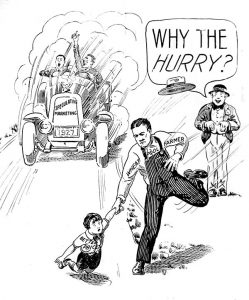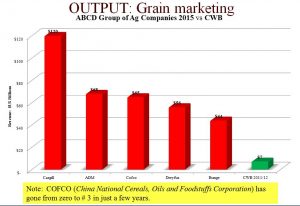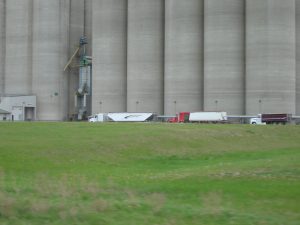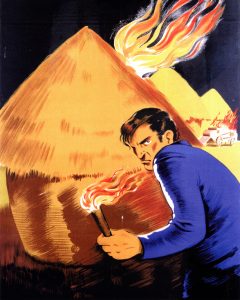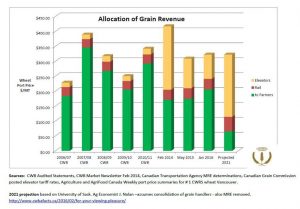Churchill rail restored
But the port only has half of its life back
(November 1, 2018) Today’s announcement by the Prime Minister that the 1,000 km. Churchill rail line is restored and will soon be in operation is very good news for the people of the Town of Churchill and the many communities along that line who depended on it for supplies and transportation.
It is also good news for Canadian northern sovereignty in an age of global warming where the Arctic Ocean will become open for shipping most of the year.
The total cost for restoring the line is being reported as $117 million, just over half of what former Harper Agriculture Minister Gerry Ritz suggested it might cost. (see note below)
In spite of the rail line’s restoration, the Port of Churchill is still only getting half of its life back. As was explained earlier, Churchill’s grain terminal was only viable when the farmer owned and directed Canadian Wheat Board was ruthless in choosing shipping terminals that returned the greatest value to prairie grain farmers – for farmers in eastern Saskatchewan and northern Manitoba that was often Churchill.
Once the Harper and Ritz administration destroyed the Wheat Board, the private trade choose to bypass Churchill in favour of using their existing facilities. Without the CWB the private grain trade now enjoys complete impunity and with it the ability to download the extra costs of using their system to the farmers and others who once benefitted from the port of Churchill.
So congratulations are in order to the Prime Minister and the Minister of Transport for restoring a vital rail link and supporting an important strategic northern port. Now to make the port financially viable, they need to take the next step and give prairie farmers the collective bargaining power they had with the Canadian Wheat Board. That would remove the built in conflicts of interest that now cost prairie farmers so much. Returning collective bargaining will give prairie farmers the chance to restore their reputation for quality, honesty, and reliability on the world stage squandered by the private grain trade.
note: Canadian Press reports the Federal Government “provided $74 million to help fix the railroad and buy it, along with the town’s port, from Denver-based Omnitrax.”
Same old from Alberta Wheat Commission
(June 28, 2018) Few things are more predicable than the creatures of the Government of Alberta making grand plans to take grain trade regulation away from the public interest and give it to the corporate sector.
This all stems from the long-standing Alberta government policy of doing everything it can to provide cheap grain for cattle feeding and other grain processors in Alberta. In a meeting I had with Walter Paszkowski, then Alberta’s Progressive Conservative Agriculture Minister, he embarrassed his handlers and startled my two companions by telling us the Wheat Board was an impediment to this policy. Some years later in a meeting with Oneil Carlier, Alberta’s current Agriculture Minister, Carlier refused to engage in a discussion about how Alberta’s Agricultural check-off groups allocated their funding to this end. Later Carlier effectively reversed a policy allowing Alberta producers to ask for their money back from the check-off commissions – demonstrating the old adage that “no matter who you voted for, the government got in.”
One of the Alberta government’s most reliable creatures is the Alberta Wheat Commission. Like the other Alberta agricultural check-off commissions, it holds the counterfeit of democratic elections to select its Board of Directors. Not surprisingly those elections regularly produce a group of people who talk about free enterprise in agriculture while ignoring the reality of the global market place and the fact, to pick just one of many examples, that only two companies, Cargill and JBS, control about 90% of beef packing in Canada. Sometimes they even do it with a straight face!
The AWC’s June newsletter is a vintage example of thinking “inside the box.” Their message is that the Canadian Grain Commission is “a legislative relic.” In the AWC’s bubble the legislative mandate of the Grain Commission to “work in the interests of farmers” apparently has no importance to either farmers or customers. Nor does the fact farmers have off-set the great cost of getting their grain to tide water (in some of the world’s worst weather through six mountain rangers) by selling quality-assured grain to quality conscious premium markets like Japan.
Instead, in the same issue AWC suggests Columbia, a small and only semi-stable Latin American country is eager to buy lower quality wheat – the implication being prairie farmers can forget about quality assurance standards and sell to the Columbias of this world. It has apparently never crossed the serene minds at AWC that farmers make less if they grow low quality wheat for poor markets.
Their June newsletter also makes the laughable suggestion that inspections by private contractors can replace the objective quality assurance provided by the Canadian Grain Commissions’ grain inspections. The CGC has a sterling international reputation for honesty and objectivity. That’s why our customers trust their inspections.
Apparently to the AWC what our customers want, and the credibility of our grading and export system does not matter. Perhaps AWC has already forgotten Japan imposed a ban on prairie wheat last week because of genetically modified wheat plants found in Southern Alberta.
The AWC does not seem to recall that since the Harper administration killed the Canadian Wheat Board in 2011, international customers have consistently made complaints that our quality standards are slipping. So aside from the deep thinkers at the Alberta Wheat Commission, who exactly is asking us to lower our inspection standards and harmonize our grading system with the US? Certainly not our customers.
Reading the AWC’s publications makes it clear they are reliability promoting an economically illiterate Alberta Government policy from the 1970s to “walk all the grain off the prairies.” That isn’t in the best interests of prairie farmers no matter what the AWC claims. Our customers want high quality standards and we should listen to them.
Harper legacy kills another premium wheat market
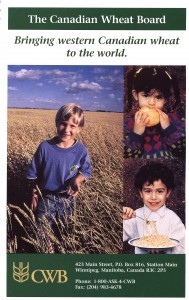 (June 15, 2018) Japan has announced the (hopefully temporary) suspension of wheat purchases. The suspension followed quickly after the Canadian Food Inspection Agency’s announcement yesterday of the discovery of genetically modified glyphosate-resistant wheat in southern Alberta.
(June 15, 2018) Japan has announced the (hopefully temporary) suspension of wheat purchases. The suspension followed quickly after the Canadian Food Inspection Agency’s announcement yesterday of the discovery of genetically modified glyphosate-resistant wheat in southern Alberta.
Japan was always one of our Canadian Wheat Board’s customers willing to pay premium prices for quality-assured prairie wheat and barley – so much so the CWB maintained a full time office in Tokyo.
One of the reasons the Canadian Wheat Board insisted on caution about introducing Monsanto’s genetically modified wheat in the 2000s was the almost universal response from wheat buyers across the world that they would not purchase the stuff. As any smart marketer knows, “the customer is always right” and “quality always sells.” The customers didn’t want GM Wheat so Canadian farmers and their Wheat Board smartly listened to what their customers wanted.
Speaking of the opposite of smart marketing, last week the Alberta and other prairie Wheat Commissions received a longish screed calling for the end of our prairie wheat grading system and its harmonization with the much lower US standards. The authors of this screed included many of the usual anti-Wheat Board activists that had gained the ear of the affable but destructive former Premier of Alberta Ralph Klein and former Harper Agriculture Minister Gerry Ritz.
Other buyers of prairie grain are already unhappy with the continual failings of the big US grain companies to provide quality-assured Canadian prairie grain. If they follow Japan’s example, wheat farmers facing falling prices with bulging bins will be looking for answers. They need look no further than the Harper Conservative Members of Parliament who did the bidding of the tiny minority of malcontents that wanted our Wheat Board killed. A lot of the anti-CWB activists pushing to kill our grading and quality assurance systems are the same people who wanted GM wheat introduced into western Canada. You can bet they have no plans to take responsibility for this mess.
With the Canadian Wheat Board prairie grain producers collectively sold their grain to over 70 countries around the world with much of that going to premium markets like Japan. Now prairie grain farmers sell individually to just a tiny handful of private companies in a market effectively controlled by just three giant corporations.
Whatever happens with grain sales as a result of this GM mess, you can bet the big grain companies will pass any and all extra costs back to farmers as lower prices. Along with declining prices and totally bungled delivery logistics, the Harper Administration’s legacy of killing the CWB just keeps on taking from prairie farmers and giving to the big grain companies.
NOTES AND UPDATES
Author’s note: to be scrupulously fair, it should be noted that a few of the anti-CWB activists I met at that time actually supported the CWB’s caution about the introduction of GM wheat, although it did not change their views about ending the single-desk and orderly marketing.
Other articles among many on this subject:
https://www.manitobacooperator.ca/2009/11/05/monsanto-ponders-gm-wheat-for-canada/
http://www.nfu.ca/story/gm-wheat-contamination-incident-reminder-need-better-regulation
Note: this story has been revised.
Don’t blame the trains
(May 8, 2018) Prairie grain farmers live and die by the prices and delivery opportunities for their grain. On both counts farmers have a strong sense of being short changed. When the price looks good and the basis is low, the elevator is often plugged. When the basis is high making the offered price lower, the elevator has space for deliveries.
This smells like the bad old days when farmers brought grain to the elevator only to have the agent tell them there was no space for their number one wheat but there was still room for lower priced wheat if they wanted to take less. Now farmers are again finding elevators plugged when the price is high. The important question becomes: are farmers being short changed by the railways or by the grain companies?
This past winter the grain companies have been telling farmers and pretty much anybody that would listen that the railways are not delivering rail cars. They claim poor rail service is why elevators are plugged so farmers cannot deliver their grain and ships are waiting at port. High basis costs and lower prices are sometimes blamed on the railways as well. Is rail service for grain shipments really that bad? If it is then our grain exports should show it.
There are objective numbers about grain shipments and exports from Canada. According to the Canadian Grain Commission, as of crop week 39, which ended April 29, 2018, overall grain exports are only down a tiny 2.1% compared to the same week last year. Remember that last crop year, the Canadian Transportation Agency found the railways delivered 7% more grain than the previous year – almost a new record. In 11 of the 39 crop weeks overall exports are seldom down more than 1% and most of the missing export volume is accounted for by increased domestic use and the fall of canola and pulse exports.
However, the real eye-openers are the numbers for wheat. Up to April 29/18 total wheat exports are up a blistering 14.75% compared to last year. The CGC also reports that in every week of the 2017-18 crop year Canada exported substantially more wheat than in the same period for the previous crop year. Claims by elevator agents they have no room ring hollow when their grain companies are moving more wheat than ever to export position.
Even barley exports are up 66.8%. Smaller crops like soy beans are down 10%, while lentils, peas, and other pulses are down more than 50%, mostly because of Indian tariffs. Canola is down 5.4% and durum is down 10% after the private trade bungled quality assurance. It is these last two crops which account for the biggest part of that overall 2.1% drop in export grain shipments. It is the grain companies who are responsible for customers turning away from prairie canola, durum wheat, and pulse crops.
It is notable the private trade has bungled quality assurance on the grains with poor export numbers.
Without a single-desk marketer to manage logistics and deal with quality assurance there is no way prairie farmers will receive full value for their grain and customers will get what they want – when they want it. So there is little evidence for blaming the trains, at least this time.
In spite of what you may read in some of the business press, the year-to-date export numbers from the Canadian Grain Commission show the railways are doing their job. So farmers and their former customers are the ones being short changed in many ways by the grain companies.
Oil by Rail is Trivial
Oil by rail is another excuse used by grain company apologists to divert attention from their poor management. The National Energy Board publishes monthly figures for oil shipments crossing the Canadian border by rail. The highest shipment month since 2012 was December of 2014 at 27,913 cubic meters (m³) of oil per day. As of February 2018 oil by rail is down to 21,306 m³ per day. It sounds like a lot of oil, but it is only 163 oil tank cars a day. This is a drop in the bucket compared to the roughly 1,300 grain cars a day that moved last year’s grain crops to port.
Most oil still goes south into the United States to be refined. Grain goes west to the Pacific. Adding oil transport to rail does not use the same tracks or mountain passes as grain – at least not for now. Scaling up rail operations to meet extra demand for shipping oil south is a matter of adding extra locomotives and crews.
Ag dwarfs oil
(April 19, 2018) It was Friday the 13th and on CBC Calgary’s Eye-Opener its business commentator reported that Saudi Aramco, the world’s largest oil company had a net income of US $33.8 billion in the first six months of the year on a cash flow of US $52 billion. It sounded like he was about to go into rapture right on the air. But hey, the show was coming from Calgary, Alberta where they have long ago forgotten their heritage as the birth place of the Alberta Wheat Pool much less the critical role played by Albertans in the formation of the Canadian Wheat Board.
This demonstrates how most people are unaware of the invisible giants of agriculture that take so much money from prairie grain farmers and the Canadian economy. Just three years ago the public face of Cargill made US $120.4 billion and ADM made US $67 billion. Combined this is three times what Saudi Aramco took. Adding in the world’s third largest grain trader, COFCO (China National Cereals, Oils and Foodstuffs Corporation) at US $65 billion gives these grain traders combined revenue of over US $250 billion making Aramco look positively tiny by comparison.
These top three grain traders now control over 70% of the world’s grain. The formerly mighty Louis Dreyfus and Bunge are in fourth and fifth place. With the exception of a handful of other tiny grain companies these big five trade essentially all the grain in the world. The stakes in agriculture are very high and as the CBC commentator demonstrated, most people are oblivious.
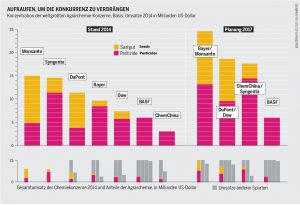 For those who regard giant companies dominating a market sector with some suspicion, it just keeps getting worse for both prairie farmers and people who like to eat. With announcement of the US Department of Justice’s approval of the US $66 billion merger of Monsanto and Bayer, the giants on the input side of agriculture are getting a lot larger too. This merger on the agrochemical-seed side was preceded last year by the mergers of Dow with DuPont and Syngenta with ChemChina. Outside of Canada, these three companies now control almost 100% of the world’s agricultural seed development and over 70% of the world’s agrochemical market.
For those who regard giant companies dominating a market sector with some suspicion, it just keeps getting worse for both prairie farmers and people who like to eat. With announcement of the US Department of Justice’s approval of the US $66 billion merger of Monsanto and Bayer, the giants on the input side of agriculture are getting a lot larger too. This merger on the agrochemical-seed side was preceded last year by the mergers of Dow with DuPont and Syngenta with ChemChina. Outside of Canada, these three companies now control almost 100% of the world’s agricultural seed development and over 70% of the world’s agrochemical market.
Years ago prairie farmers met those giants by building cooperative grain handling systems, marketing collectively through the Canadian Wheat Board, and financing public interest plant breeding. Essentially western Canada was operated as a gigantic virtual grain farm when it came to quality assurance and grain sales.
Working together provided huge price premiums to prairie farmers. With the killing of the Wheat Board those premiums are now being vacuumed up by the giant grain companies. For the first time in living memory number one Canadian hard red spring wheat is now usually trading at a discount to inferior US dark northern spring wheat.
While the giant agrochemical and seed companies are consolidating to take more from prairie grain farmers on the input side of things, in Ottawa the Liberals and their feckless Agriculture Minister are carrying on with the Harper government’s plan to privatize the Canadian developed genomes for wheat, barley, oats, and other essential grains while the Alberta NDP’s agriculture Minister keeps his head down.
In an Orwellian bit of misdirection this process of taking control of cereals genetics away from prairie farmers and giving it to the giant agrochemical seed companies of this world is being titled Value Creation Working Group Grains Roundtable. What it really means is taking the value of the seed genome developed by farmers and the Canadian public and giving its control and profits over to giant foreign agrochemical seed companies.
So while Alberta, BC, and Ottawa are in a lather about what amounts to chump change being lost because of what they claim is inadequate oil pipeline capacity to the coast, the really big money continues to be stolen from prairie grain farmers by the invisible giants of agriculture and siphoned to their shareholders.
International Women’s Day 2018
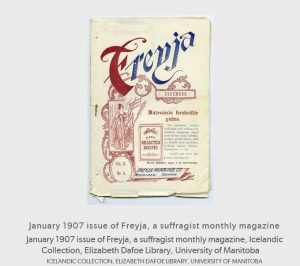 (March 8, 2018) On this international women’s day I learned of the longest running suffrage magazine in Canada. Freyja was published in Manitoba in Icelandic beginning in 1898 and ending in 1910. At the time it was considered the only such magazine being published in Canada. Its editor was Margret Benedictsson.
(March 8, 2018) On this international women’s day I learned of the longest running suffrage magazine in Canada. Freyja was published in Manitoba in Icelandic beginning in 1898 and ending in 1910. At the time it was considered the only such magazine being published in Canada. Its editor was Margret Benedictsson.
This reminded your writer of a presentation called “Women of the Aspenland” from the mid 1990s in Alberta. Women of the Aspenland highlighted the leadership roles played by women working together on the various farm and community groups to enhance the collective market power of everyone from grain farmers to hog growers and their contributions to Canadian society.
 Hazel Braithwaite, one of our neighbours, was recognized for her long involvement with the United Farm Women of Alberta: “Her concerns, she said, were anything that affected the farm family.” She was later commemorated with a life-sized bronze statue by the City of Red Deer.
Hazel Braithwaite, one of our neighbours, was recognized for her long involvement with the United Farm Women of Alberta: “Her concerns, she said, were anything that affected the farm family.” She was later commemorated with a life-sized bronze statue by the City of Red Deer.
As readers page through the various central Alberta communities they may be surprised to see the range and multicultural variety of women and their involvement in building Central Alberta. It would be possible to build a similar list for most of prairie Canada and those lists would be heavily weighted towards farm women. A surprising thought given the difficulties of transportation in the early days.
 In contrast with the older settlements of eastern Canada, prairie farm women occupied strong leadership roles with equal voice and votes in farm politics. Rural prairie settler culture was not perfect, as the life of the pioneer Manitoba journalist Margret Benedictsson showed, but through hard work and an open prairie culture, farm women were considered “persons” in every sense of the word long before the famous five prairie women established this fact in law.
In contrast with the older settlements of eastern Canada, prairie farm women occupied strong leadership roles with equal voice and votes in farm politics. Rural prairie settler culture was not perfect, as the life of the pioneer Manitoba journalist Margret Benedictsson showed, but through hard work and an open prairie culture, farm women were considered “persons” in every sense of the word long before the famous five prairie women established this fact in law.
Trudeau’s China agenda damaged by recent history
 (December 12, 2017) Over the past months the Canadian media has been filled with stories characterizing trade with China as either a golden opportunity or a blind walk into a totalitarian trap. There is the offensive smell of long standing racism mixed with the patronizing greed that has characterized most western relations with the Middle Kingdom for centuries.
(December 12, 2017) Over the past months the Canadian media has been filled with stories characterizing trade with China as either a golden opportunity or a blind walk into a totalitarian trap. There is the offensive smell of long standing racism mixed with the patronizing greed that has characterized most western relations with the Middle Kingdom for centuries.
In this country we lack a deep sense of our own history. Add in a lamentable lack of Canadian academics who actually work on Canadian history and you have a formula for the forgetfulness now on display about trade with China. The neglect of that history has contributed to the mess facing Canada-China relations today.
After the Korean war America led a boycott and food embargo against China which the grain farmers of western Canada defied. That food embargo caused wide-spread starvation in China. You would not know it from the current crop of politicians and commentators, but Canada, or at least western Canada, started developing a mutually respectful trading relationship with China when the CWB ignored the American-led embargo and sold almost four million bushels of wheat to China in 1958. Then the CWB signed a three year agreement with China in 1960.
The American embargo and their pressure on Canada to stop selling grain to China were offensive to Paul Babey, the leader of the Farmers’ Union of Alberta and most of its province-wide membership. As a young boy I can remember the FUA local members meeting in our family dining room to discuss and ultimately pass a motion to support sending a new trade delegation to Mao’s China to negotiate grain, food, and machinery sales to that starving and recently war-torn land.
The next year Babey and a delegation including the heads of the Prairie Wheat Pool Cooperatives and the Canadian Wheat Board went to China with the blessing of John Diefenbaker’s Conservative government. They promptly enraged the Americans by signing another sales agreement with China for prairie grain. That was in 1964 and since then China was one of the Canadian Wheat Board’s most reliable customers – so much so that the CWB developed a full time office in Beijing.
Unfortunately this relationship of mutual trust was destroyed in 2011 when the Harper Conservatives destroyed the Canadian Wheat Board. China was effectively told by the Harper government to go to the much-disliked private American grain trade to secure its supplies of Canadian grown grain. As was said here before, “For the Chinese this will represent a betrayal of trust by their Canadian counterparts that they will not soon forget.”
Adding insult to injury, last year when China asked for the same purity standards for Canadian canola as they were accustomed to being guaranteed on Canadian wheat our Prime Minister further insulted them when he took the side of the big foreign grain companies by insisting Chinese expectations were unscientific.
Former Wheat Board staff familiar with trading in Asia – both China and Japan were long standing premium customers – told this writer and many others the key to trading in China was establishing a relationship of trust and respect.
The Prime Minister’s insulting insistence on establishing a one-size fits all free trade agreement with China is simply another example of what I’m sure many in China and elsewhere will see as an arrogant and historically ignorant approach.
Some years ago, the farmer-led CWB pointed out that bi-lateral agreements, modelled on its long experience in China, other Asian countries, the Middle East, and Russia were the much-preferred route for a country like Canada where relationships of mutual trust and understanding were established.
Our good relationship with China is gone now. Once the Harper Conservatives killed the Canadian Wheat Board, the Chinese government agency China National Cereals, Oils and Foodstuffs Corporation (COFCO) transformed itself from a reliable customer for Canadian grain into a major international grain trader. Within less than three years COFCO shook up the structure of the international grain trade for the first time in over 100 years by becoming the third largest grain trader in the world.
COFCO changed into a very strong player in the international grain trade for the simple reason that China will never again allow its food security to be threatened by the US-dominated private grain trade.
Ottawa still has the chance to rebuild the relationship with China by re-establishing a farmer-controlled Canadian Wheat Board. Aside from restoring the full value of Canadian grain to the prairie farmers who produce it, the restored CWB could salvage the relationship it built with China over the 48 years after the Farmers Union of Alberta and the CWB first demonstrated the honesty, quality assurance, and reliability Canadian grain became known for.
End of Wheat Board marks end of frontier values of cooperation and equality
(August 1, 2017) The end of the Canadian Wheat Board five years ago certainly proves that unregulated capitalism works very effectively for the powerful and well organized. Declining numbers and increasing debt show it does not work for farmers.
The CWB was a hybrid organization providing farmers with collective bargaining power, a professional standards association, and a world-wide reputation for honesty, quality-assured product, and reliable delivery.
Oh, and it also dependably got farmers 88% or better of the world price for their grain after all the costs for transportation and marketing had been paid. Now farmers are lucky to get 60% of the world price and the private trade is scooping up record profits from money that once ended up in farmers’ bank accounts. Their local communities are seeing less spending thanks to farmers’ declining share of the world price too.
Prairie farmers also had a very efficient storage and transportation system which was “right sized” to handle the whole prairie grain crop due to the CWB’s intelligent management. Now that intelligence is gone and the private trade is racing to make farmers pay for increased capacity in both inland storage facilities and port terminals.
Never-the-less the vast majority of prairie delivery points are only serviced by a single company — two thirds in Manitoba and three quarters of the points in Alberta and Saskatchewan have only one elevator company. So most farmers are finding themselves at the mercy of only one grain company and their new master is the elevator agent who decides which farmers get to deliver grain, when, and what each farmer gets paid.
The irony of having less choice as a result of a vociferous minority attacking the CWB demanding more choice is not lost on those who understand how the system works.
One of the first things that happened with the end of the CWB was an avalanche of complaints from former customers about poor quality control and unreliable delivery. The end result was one of those customers, the Government of China, used its economic muscle to push aside the much reviled private grain trade and establish its own central grain trading agency (COFCO) as the third largest grain trader on the planet pushing the smaller Louis Dreyfus and Bunge down to fourth and fifth place.
This changed the 140 year old order of the ABCD group of oligarchs on their perches but does nothing for prairie farm gate prices. Combine this upset with further consolidation of prairie grain handling and it makes the predictions from a U of Sk. Ag Economist that farmers will see their share of the grain price pushed down to just 20% seem closer to reality.
Now that the CWB is no longer there to speak to the importance of quality control and meeting customer demands, as they did when Monsanto attempted to introduce GM wheat some years ago, we are also seeing moves to further privatize the cereals genome. We must remember this genome was paid for by prairie farmers and Canadian tax payers for the public good.
Those are the big changes, but there have been relatively smaller ones as well, not least of which is the loss of Canada’s only northern sea port and its physical isolation with the loss of the Churchill rail line.
Western historian Patricia Limerick suggests: “the frontier ends when the pimps come to town” something prairie grain growers are becoming all too familiar with as they negotiate a world without the CWB in which they no longer have any control and precious little dignity.
The cost of losing food sovereignty
CWBA presentation to rural Alberta NDP
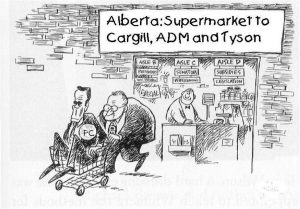 (April 23, 2017) A few weeks ago I was invited to the annual general meeting of the Alberta NDP Party’s Rural Caucus to give a 20 minute presentation on issues facing agriculture which you can read here. The meeting was held in Camrose, Alberta, in the heart of some of the most productive farm land in Alberta.
(April 23, 2017) A few weeks ago I was invited to the annual general meeting of the Alberta NDP Party’s Rural Caucus to give a 20 minute presentation on issues facing agriculture which you can read here. The meeting was held in Camrose, Alberta, in the heart of some of the most productive farm land in Alberta.
The audience for this meeting consisted of rural NDP activists and supporters as well as several NDP MLAs from rural ridings, members of the party brass, a couple of “stakeholder relations” people attached to the Premier’s office, and the Minister of Agriculture.
I opened by pointing out that Canadian literature, at least according to some Upper Canadians, is all about the theme of individual “survival” but that the theme of western Canada’s history is one of cooperation and collective prosperity. That prosperity, I argued, is based on our sovereignty – our collective ownership and control of our grain production.
As said before, you can download and read an annotated version of the presentation by clicking here. It covers the great grain robbery since the CWB was killed, concentration of ownership in global agriculture, and the background to the current moves to privatize the cereals genome being carried out by the residue of the Harper government in Ottawa with help from Alberta Astroturf.
Lest readers assume that the Alberta NDP actually listened to any of this, not even two weeks later Minister Carlier introduced Bill 9 which gives the Alberta Astroturf check-off organizations the right to levy non-refundable production taxes on Alberta’s farmers – giving new meaning to “taxation without representation.” This was met with condemnation by many of the active farmers who are still Alberta NDP party members and by comments on Alberta Politics.
One of the bedrocks of democracy is the secret ballot. Even in Saskatchewan, behind another kind of Wall, farmers have a secret mail-in ballot for electing their agricultural check-off groups. Given Bill 9, this is something Alberta farmers can only dream of now.*
This Alberta debacle is further evidence that losing food sovereignty is soon followed by a loss of political sovereignty.
*As of this writing The Alberta Canola Commission, which actually uses a mail in ballot system is the exception among the Alberta check-off commissions.
The right to repair your own farm machinery
(March 28, 2017) Most of us have purchased a DVD movie and watched the threats of jail and fines for copying the content on the opening screen. Any farmer who has purchased private sector based canola seed (and paid seven times the cost of publically created Certified Seed) knows about these types of draconian copyright notices and contracts as well.
What many farmers may not know is the same types of provisions (laughably called “protections”) are now being applied to the software which runs those nice display monitors in newer combines, tractors, and other farm equipment.
Like a DVD, you may think you have bought and own the tractor but you may not own or control the software which allows it to operate.
Last week one of Canada’s best east coast writers and reporters, Parker Donham, published a column on this subject which every farmer ought to read.
Donham reports that if farmers do their own repair work, even simple mechanical repairs, this may violate the machine’s software licence and render it useless until the farmer pays the company to re-activate the software.
Last year the University of Calgary had its main computer server hacked by bandits. Using malware implanted on the system, these high-tech pirates froze the U of C’s computers until the University coughed up $20,000 to remove this “ransom ware.”
If the article by Donham is correct, farmers can be forgiven for asking exactly what is the difference between ransom ware and the firmware landmines that are apparently part of the software of some farm equipment?
Readers may recall a report cited here a couple of weeks ago which shows that global farm equipment sales are dominated by two companies. Repairing farm equipment is already complex and expensive. Farmers really do not need the added complications of contending with software that makes the process more taxing than it already is. After all, it is not like they have much choice left in the matter.
You can read Donham’s article here: “The right to repair your own tractor.”

